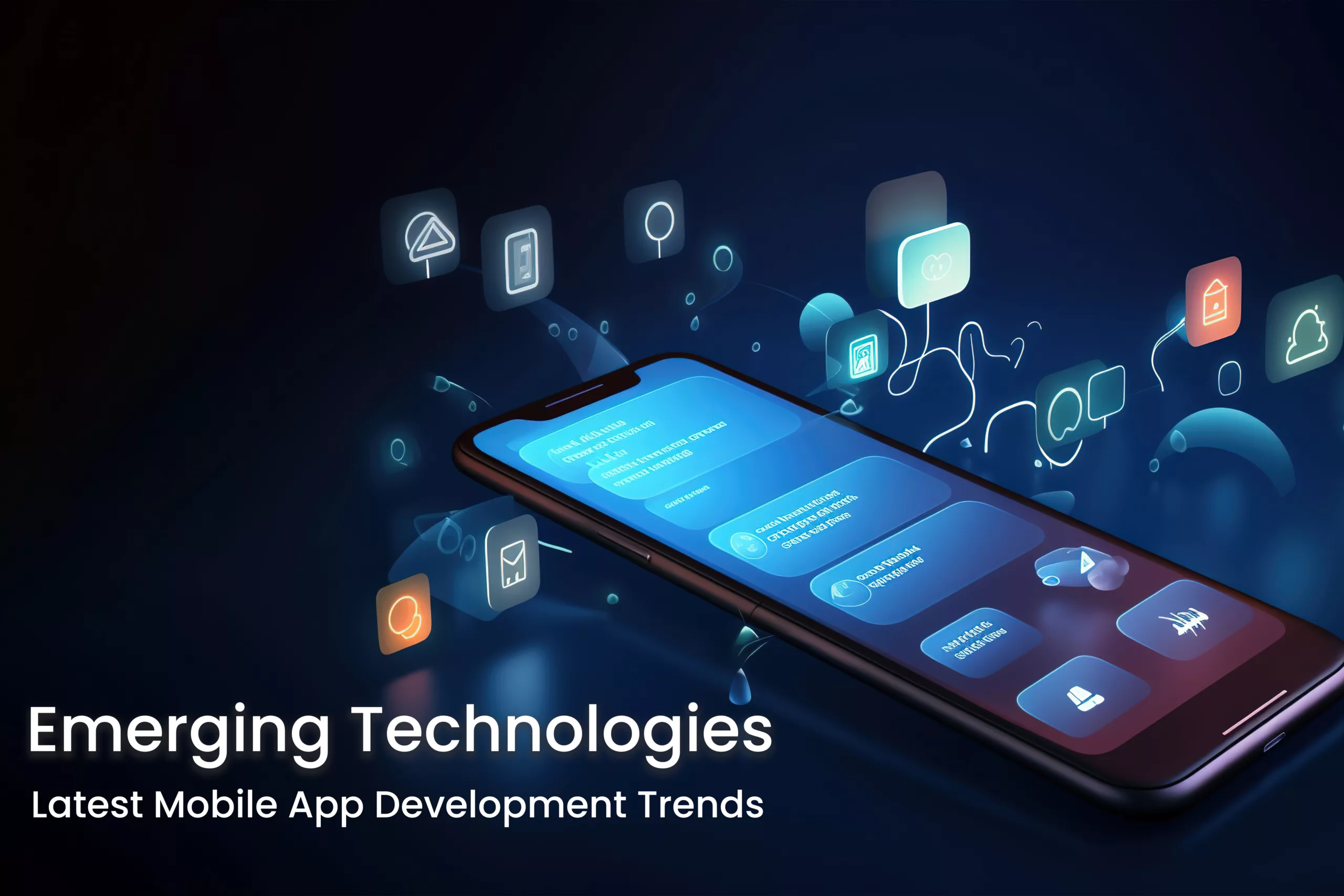The global market for mobile apps is on a powerful trajectory. Experts predict it could hit a whopping $756 billion by 2027, growing at an impressive rate of 8.58% every year. This remarkable surge highlights how much impact mobile apps have on our daily lives.
In this blog, we’ll explore mobile app development trends, which is like peering into a crystal ball of technology. From cool new features to things that make apps easier for us, the future of making apps looks really exciting.
So, let’s dive in and discover what’s in store for the world of mobile app development.
Emerging Technologies Latest Mobile App Development Trends

Mobile app development plays a pivotal role in shaping the industry’s trends. The integration of cutting-edge technologies not only enhances the capabilities of mobile applications but also opens up new possibilities for innovative and engaging user experiences.
In this section, we will explore emerging technologies that are making a significant impact on mobile app development.
5G Technology
As 5G networks continue to roll out globally, the implications for mobile app development are profound. The increased speed and low latency offered by 5G networks enable you to create of more sophisticated and data-intensive applications. This includes high-quality video streaming, augmented reality (AR) applications, and real-time collaboration features, enhancing the overall user experience.
Augmented Reality (AR) and Virtual Reality (VR)
AR and VR technologies have transcended gaming and entertainment, finding practical applications in various industries through mobile apps. AR and VR trends for mobile app development involve enhancing the real world by overlaying digital information and creating immersive, computer-generated environments. Mobile apps leveraging these technologies are increasingly used in areas such as education, healthcare, and retail, providing users with interactive and engaging experiences.
Internet of Things (IoT) Integration
The proliferation of IoT devices has increased demand for mobile apps that can seamlessly integrate and communicate with these devices. Mobile applications can now control and monitor smart home devices, wearables, and industrial IoT solutions. This interconnected ecosystem offers users greater control over their surroundings and facilitates a more connected and efficient lifestyle, aligning with new mobile app development trends.
Machine Learning and Artificial Intelligence (AI)
The integration of AI and machine learning algorithms in mobile apps is transforming how applications understand, analyze, and respond to user behavior. AI-driven features, including personalized recommendations, predictive text input, and image recognition, enhance user engagement and satisfaction. Virtual assistants and chatbots powered by AI provide a more natural and intelligent interaction within mobile applications, reflecting top trends in mobile app development.
Blockchain Technology
Blockchain technology in mobile app development trends enhances security, transparency, and trust. It can secure transactions, verify data integrity, and enable decentralized applications (DApps). Particularly relevant in finance, healthcare, and supply chain management, mobile apps leveraging blockchain with the latest trends for mobile app development where data security and integrity are paramount.
Edge Computing
Edge computing in mobile app development trends is gaining prominence as a technology complementing the capabilities of cloud computing. Processing data closer to the source (at the edge of the network) allows mobile apps to achieve lower latency and faster response times. This is particularly beneficial for applications requiring real-time processing, such as augmented reality and Internet of Things applications, showcasing top trends in mobile app development.
User Experience (UX) and User Interface (UI) Design

In mobile app development trends, the emphasis on User Experience (UX) and User Interface (UI) design has become pivotal. The seamless integration of these elements ensures user satisfaction, contributing significantly to the overall success and adoption of a mobile app.
Focus on Intuitive and Seamless Experiences
- User-Centric Approach: The emphasis on understanding user behavior, preferences, and expectations is crucial. Designers are increasingly adopting user-centric methodologies, conducting user research, and employing feedback loops to create interfaces that resonate with the target audience.
- Intuitive Navigation: Simplifying navigation structures and minimizing cognitive load are paramount. App developers are embracing minimalist design principles, streamlining user journeys, and placing essential features within easy reach to enhance overall usability.
- Consistency Across Platforms: Maintaining consistency in design elements, interaction patterns, and branding across different platforms ensures a cohesive experience. This consistency, both in visual elements (UI) and overall flow of interactions (UX), is key in aligning with current trends in mobile app development.
Minimalist Design and User-Centric Approaches
- Sleek Aesthetics: The trend toward minimalist design continues to gain momentum. Clean, uncluttered interfaces with a focus on essential elements not only enhance visual appeal but also contribute to faster loading times and improved performance.
- Microinteractions: Attention to detail in the form of microinteractions, such as subtle animations or feedback responses, adds sophistication to the user experience. These small, thoughtful details significantly impact user engagement and satisfaction, aligning with new trends in mobile app development.
- Personalization and Customization: Tailoring the app experience to individual user preferences is becoming more prevalent. Apps that allow users to customize layouts, themes, and content enhance user satisfaction and contribute to a sense of ownership and personal connection, reflecting the current trends in mobile app development.
Cross-Platform Development

With the diversity of mobile devices and operating systems, cross-platform development has emerged as a strategic approach to ensure wider reach and efficient utilization of resources in the app development process.
Advantages and Challenges
- Wider Reach: Developing apps that can run seamlessly on multiple platforms, such as iOS and Android, provides a wider reach. This approach eliminates the need for separate development efforts for each platform, aligning with trends in mobile app development.
- Cost Efficiency: Cross-platform development frameworks like React Native and Flutter enable you to write code once and deploy it across different platforms. This significantly reduces development costs and accelerates time-to-market.
- Challenges in Native Features: While offering efficiency, challenges may arise in fully leveraging platform-specific features. Striking the right balance between a unified codebase and platform-specific optimizations requires careful consideration, highlighting the nuances of current trends in mobile app development.
Frameworks Facilitating Cross-Platform Development
- React Native: Developed by Facebook, React Native has gained widespread adoption for its ability to build native-like experiences using JavaScript and React. It allows you to reuse code across platforms while maintaining native performance.
- Flutter: Google’s Flutter has gained popularity for its expressive UI framework. It enables the creation of visually rich, natively compiled applications for mobile, web, and desktop from a single codebase.
- Xamarin: Owned by Microsoft, Xamarin allows you to use C# for cross-platform development. It provides native performance and access to platform-specific APIs, facilitating seamless integration with device features.
Security and Privacy Concerns

In an era dominated by the latest trends in mobile app development and digital interactions, the paramount importance of security and privacy in mobile app development trends cannot be overstated. Users entrust their personal information to apps, making it imperative for you to implement robust measures to safeguard data and ensure user trust.
Growing Importance of App Security
- Data Encryption: With the increasing frequency of cyber threats, data encryption has become a cornerstone of app security and one of the critical enterprise mobile app development trends. Implementing strong encryption protocols ensures that sensitive user data remains confidential, even in the event of a security breach.
- Secure Authentication: Multi-factor authentication and biometric authentication methods, such as fingerprint or facial recognition, enhance the security of user accounts. These measures add an additional layer of protection beyond traditional username and password combinations, aligning with the latest trends in mobile app development.
- Regular Security Audits: Conducting routine security audits and vulnerability assessments is essential. Identifying and addressing potential security flaws proactively can prevent security breaches and protect user data from unauthorized access, aligning with current trends in mobile app development.
Compliance with Privacy Regulations
- GDPR and Data Protection: The General Data Protection Regulation (GDPR) and similar data protection laws worldwide require you to prioritize user privacy, reflecting the latest trends in mobile app development. Adhering to these regulations involves obtaining explicit user consent for data collection and ensuring transparent privacy policies.
- Privacy by Design: Integrating privacy features from the outset, known as “privacy by design,” is a best practice and one of the crucial trends in mobile app development. This involves considering data protection at every stage of development, minimizing data collection, and providing users with control over their personal information.
- User Education: You are increasingly focusing on educating users about privacy features and how their data is used. Transparent communication builds trust, and informed users are more likely to engage with apps that prioritize their privacy.
App Monetization Strategies

Monetization is a critical aspect of app development, enabling sustainability and growth. As the mobile app development trends evolve, developers are exploring diverse strategies to generate revenue while maintaining a positive user experience.
Subscription Models
- Premium Subscriptions: Offering premium content or features through subscription models allows you to create a recurring revenue stream. Users pay a subscription fee to access enhanced functionalities, exclusive content, or an ad-free experience.
- Freemium Models: Freemium apps provide basic functionalities for free but offer premium features or content through in-app purchases. This model attracts a broader user base while enticing users to upgrade for additional benefits.
- Subscription Tiers: Implementing tiered subscription plans provides users with options based on their needs and budget, showcasing the adaptability of trends in mobile app development. This flexibility enhances user satisfaction and encourages long-term commitment.
In-App Purchases and Freemium Models
- In-App Purchases: Virtual goods, upgrades, or additional features available for purchase within the app contribute to revenue generation. This model is prevalent in gaming apps and applications offering digital content.
- Ad-Based Monetization: Displaying advertisements within the app is a widely used strategy. Developers can opt for banner ads, interstitial ads, or rewarded ads, balancing revenue generation with user experience to avoid intrusive advertising.
- Strategic Partnerships: Collaborating with other businesses or platforms for cross-promotions, sponsored content, or affiliate marketing can diversify revenue streams. Such partnerships can enhance app visibility and attract a larger audience.
Sustainability in App Development

As the world increasingly focuses on environmental conservation and responsible business practices, the concept of sustainability has permeated various industries, including app development. Sustainable app development involves adopting practices that minimize environmental impact, optimize resource usage, and promote long-term viability.
Energy-Efficient Coding Practices
- Optimized Resource Consumption: You are increasingly mindful of the resources your apps consume, aligning with current trends in mobile app development. Efficient coding practices, such as minimizing background processes and optimizing algorithms, contribute to reduced energy consumption, extend device battery life, and lessen the environmental footprint.
- Server-Side Optimization: Cloud computing and server-side optimization play a crucial role in sustainability, offering mobile app development profit tips. By optimizing server infrastructure, apps can deliver content more efficiently, reducing the overall energy consumption associated with data transfer and storage.
- Green Hosting: Choosing environmentally friendly hosting services powered by renewable energy sources is part of sustainable development goals, contributing to new trends in mobile app development. Data centers and hosting providers are increasingly investing in green technologies to minimize their carbon footprint.
Green App Development Initiatives
- Carbon Footprint Tracking: Some app development frameworks and platforms now include tools to measure and track the carbon footprint of applications. You can use this data to make informed decisions on optimizing their code and reducing environmental impact.
- Renewable Energy Certificates (RECs): Apps can contribute to sustainability by purchasing Renewable Energy Certificates (RECs) to offset their energy consumption, a practice in line with mobile app development industry trends. This involves investing in renewable energy projects, such as wind or solar, to counterbalance the environmental impact of app operations.
- Eco-Friendly Design Principles: Sustainable app development goes beyond code. Design choices, such as utilizing dark mode to reduce screen energy consumption or incorporating energy-efficient animations, contribute to a more eco-friendly user experience.
Future Predictions

As the mobile app development landscape evolves, sustainability is expected to become an increasingly integral aspect of the industry. Developers, businesses, and consumers alike are recognizing the importance of creating and supporting apps that align with environmental and ethical considerations.
Continued Growth of Mobile Apps
- Increased User Awareness: Users are becoming more environmentally conscious, influencing their choices in app selection. Sustainable apps that prioritize energy efficiency and responsible practices are likely to gain favor among users.
- Regulatory Pressure: Governments and regulatory bodies are increasingly focusing on environmental regulations. The app development industry may face more stringent requirements to adhere to sustainability standards, encouraging you to adopt eco-friendly practices.
Integration of Emerging Technologies
- AI for Optimization: Artificial Intelligence (AI) and machine learning algorithms will play a role in optimizing app performance and energy efficiency. Smart algorithms can dynamically adjust resource usage based on user behavior, contributing to sustainability.
- Blockchain for Transparency: Blockchain technology may be employed to enhance transparency in sustainable practices, illustrating an innovative aspect of new trends in mobile app development. By creating immutable records of eco-friendly initiatives, developers can build trust with users and stakeholders.
Evolution of Development Methodologies
- Agile Sustainability: Integrating sustainability into agile development methodologies will become more commonplace. Sustainability considerations will be factored into sprint planning, development cycles, and continuous improvement processes.
- Collaborative Initiatives: Collaborative initiatives between developers, industry associations, and environmental organizations may lead to the creation of standards and certifications for sustainable mobile app development. These initiatives can guide you in adopting best practices for minimizing environmental impact and contributing to a sustainable digital ecosystem.
Final Thoughts
In today’s edit, we discussed the importance of keeping up with the latest mobile app development trends. That means designing apps with users in mind, making them work well on different devices, and using the newest technologies. Security is super important too – we need to make sure people’s information is safe.
Making money from apps is tricky; we want to earn money but also keep users happy. Now, there’s a big focus on being eco-friendly in app development. We’re trying to code in a way that doesn’t use too much energy and even choose hosts for our apps that use renewable energy.
Looking ahead, new tech like AI and rules about the environment will keep shaping how we make apps. It’s not just about cool features – it’s about being responsible and making a positive impact.
Want to hire mobile app developers who are updated with the latest trends and technologies? Get in touch with VinnCorp.